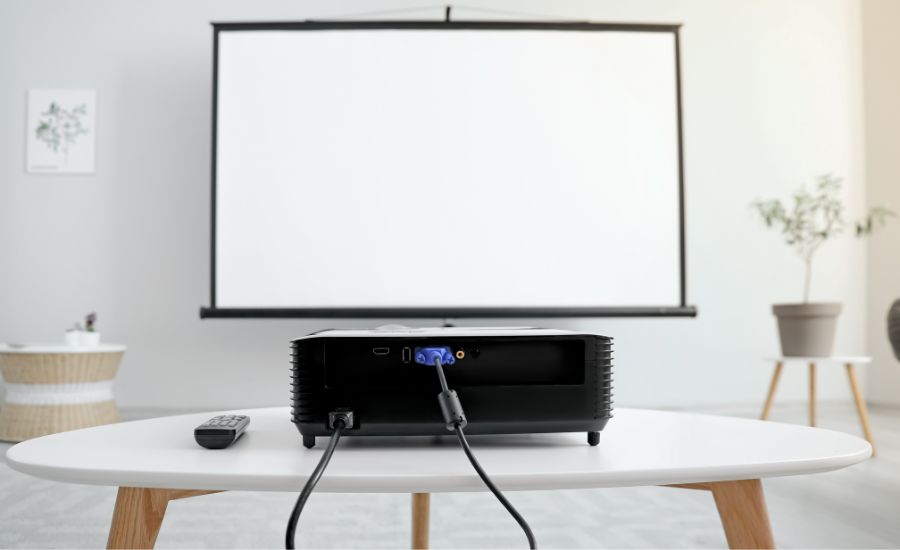In modern settings like presentations, home theaters, classrooms, and entertainment setups, most projector screens have become indispensable. Choosing the right projector screen is crucial for optimizing image quality in your home theater. In this article, we’ll explore the special features of white and grey projector screens, helping you decide based on your specific needs.

Image Quality and Performance
When considering the image performance of both screen colors, take into account your viewing environment and the preferred content type.
White Screens: Brightness
- White screens are perfect for those who seek brightness, color accuracy, and a dedicated home theater space. They are highly recommended by enthusiasts who want to experience the same cinema atmosphere at home with bright colors and sharp details.
- High-quality digital projectors complement a white color screen beautifully, delivering the clearest and sharpest imagesfor movie nights or presentations in darkened rooms. White screens are at their best in controlled lighting environments, as they are specifically designed to reflect lighting evenly across the screen material. Otherwise, it can result in poor image clarity.
Gray Screens: Contrast Performance and Ambient Light Tolerance
- One of the primary advantages of grey projector screen is their ability to enhance contrast ratio. They absorb ambient light and improve black levels in the projected image, which results in displaying darker tones with improved detail.
- A grey screen is versatile in that it can perform well in both controlled and ambient light conditions. This adaptability makes them a preferred choice in spaces where light control is challenging. Therefore, they are perfect for living rooms where you might watch sports during the day or movies at night.
White vs. Gray Screens: Content quality and performance
The choice depends on the environment setup and viewing conditions.
A white projector screen is an excellent option for planned home theaters with controlled lighting or rooms with blackout curtains and dark walls, offering accurate experiences to the creator’s intentions.
Gray screen color, however, shines in rooms with problematic ambient lighting, providing better contrast and visibility.
Viewing Angle and Screen Gain
Think about the angle of view and screen gain to ensure the best viewing experience.
White Projector Screens: Wider Viewing Angle
- White projector screen typically offers a wider viewing angle, allowing viewers to enjoy the same visual quality from various positions within the room. This makes them ideal for home theaters with multiple seating arrangements.
- The screen gain of white colored is often closer to 1.0, meaning they reflect light uniformly in all directions. This results in a broad sweet spot for viewers.
Gray Projector Screens: Limited Viewing Angle
Grey screens may have a narrower viewing angle compared to white ones. The enhanced contrast and light rejection properties can be more pronounced when viewing off-center.
Grey screens usually have a screen gain slightly below 1.0, which can limit the viewing angle.
However, they compensate for this by improving picture quality in terms of contrast and ambient light performance, making them a compelling choice compared to white or black screen.
Grey vs. White: Viewing Angle and Screen Gain
- Your choice between white and grey projector screens should align with your room layout and seating arrangements.
- White screens are excellent for rooms with flexible seating, providing a wide viewing angle and uniform brightness.
- Grey screen color is suitable for rooms with fixed seating positions or challenging light control, offering enhanced contrast and ambient light resistance.
Material and Construction
When evaluating the material and construction of white vs. grey projector screens, consider durability and maintenance requirements.
White Screen: Reflective and Durable
White projector screens are typically made from reflective materials that are designed to endure repeated use.
They are known for their durability and resistance to wear and tear.
Maintenance for white projector screen often involves simple cleaning to remove dust and smudges. They are a reliable choice for long-term use.
Gray Screen: Light-Absorbing and Resilient
Grey projector screens are engineered with light-absorbing properties to enhance contrast ratios. The materials used are designed to resist ambient light interference.
Like white screens, grey high contrast screens are constructed to withstand regular use and are durable over time. Maintenance involves similar cleaning procedures to maintain picture quality.
Grey Screen vs. White Screen: Material and Construction
Both white and grey screens are designed to be durable and reliable for use with modern projectors in home theaters.
White projector screen is constructed with reflective materials that offer long-term durability and require straightforward maintenance.
Gray screens are resilient and tailored to resist ambient light, making them a durable choice for challenging lighting conditions.

Conclusion
White and grey projector screens each have their unique characteristics and are tailored to different home theater setups and preferences.
White screen performs exceptionally well in a totally light-controlled environment.
On the other hand, grey screen thrives in rooms where dealing with ambient light is a concern.
Overall, your choice should align with your specific home theater needs, room conditions, and viewing habits. Consider these factors carefully to create the perfect cinematic experience in your own home.
Frequently Asked Questions
Is a white or grey projector screen better?
The choice between a grey and white projector screen depends on your specific needs and viewing environment. The white-colored screen is great for visualizing bright colors in a dark room with little light. Gray screen enhances contrast ratios and performs well in rooms with ambient lighting.
What color is best for projector screen?
The best projector screen color depends on the lighting conditions in your space. The white screen is suitable for controlled lighting, while the grey material screen is ideal for rooms with ambient light to have high contrast and reduce washouts.
Is grey good for a projector?
Yes, gray screens are suitable for a high-quality projector, especially in rooms with ambient lighting. They have better contrast and mitigate the impact of lightning on the projected image, resulting in better visibility and depth, particularly in darker scenes.
Do you need a white screen for a projector?
While white screens are commonly used for projectors, they are not the only option. High-contrast screens, like a black screen, are also popular, especially when dealing with too much light.

